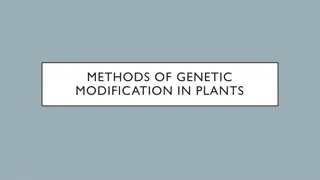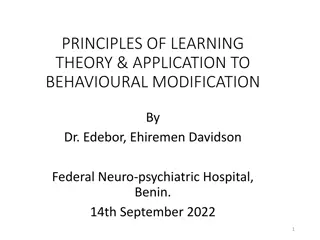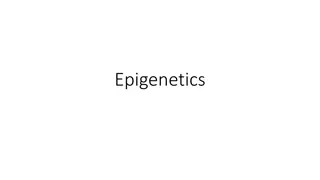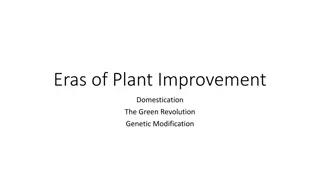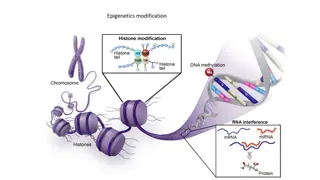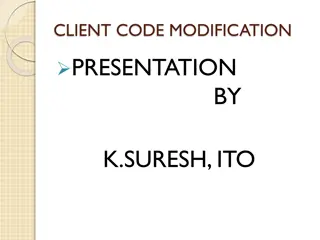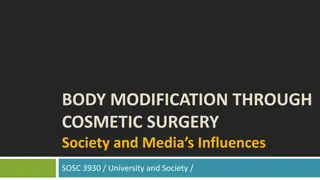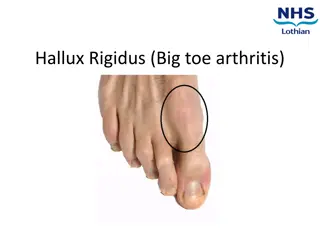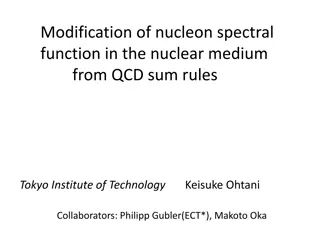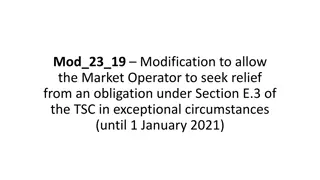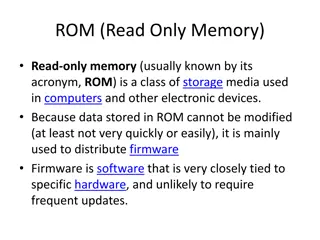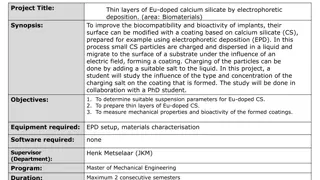Modification (CM) Updates
This presentation highlights the key updates in the 2021 ICD-10 Clinical Modification (CM), including new, revised, and deleted codes across different chapters. Major changes such as additions for injury, poisoning, substance use disorders, and guidelines for COVID-19 and Vaping Disorders are discussed. The presentation also focuses on specific chapters like Diseases of the Blood and Blood-forming Organs, Mental and Behavioral Disorders, and more.
Download Presentation

Please find below an Image/Link to download the presentation.
The content on the website is provided AS IS for your information and personal use only. It may not be sold, licensed, or shared on other websites without obtaining consent from the author.If you encounter any issues during the download, it is possible that the publisher has removed the file from their server.
You are allowed to download the files provided on this website for personal or commercial use, subject to the condition that they are used lawfully. All files are the property of their respective owners.
The content on the website is provided AS IS for your information and personal use only. It may not be sold, licensed, or shared on other websites without obtaining consent from the author.
E N D
Presentation Transcript
2021 ICD-10 Clinical Modification (CM) Updates Shawn Bromley, NEPHO Wednesday, October 14, 2020 Disclaimer: This presentation is offered as guidance to NEPHO providers and office administration. If you are a BILH employed practice please follow up with your practice Leadership on guidance reviewed during this presentation.
Agenda Final Update Review Deleted Codes Revised Codes New Codes Chapter with Big Updates Overview Chapter 3 Chapter 5 Chapter 6 Chapter 7 Chapter 13 Chapter 19 Chapter 20 Chapter 22 (New) Review revisions to ICD-10 CM Official Guidelines New guidelines for COVID-19 and Vaping Disorders
Final Update Review Effective Oct. 1, 2020, to Sept. 30, 2021, including 490 code additions, 47 revisions and 58 deletions. Among those major updates: 128 additions to Chapter 19: Injury, poisoning and certain other consequences of external causes (S00-T88) specifies fentanyl and tramadol and other synthetic narcotics. 125 additions to Chapter 20: External causes of morbidity (V00-Y99), now specifies accidental collisions involving electric scooters and other non-motor vehicle accidents. 57 musculoskeletal codes include laterality and specificity, especially codes involved with joint derangements (M24.-) 21 codes to describe withdrawal from substances including alcohol (F10), cocaine and opioids (F19). 18 codes further detailing sickle cell anemia. New codes include: D57.213 (sickle-cell/Hb-C disease with cerebral vascular involvement) D57.431 (sickle-cell thalassemia beta zero with acute chest syndrome) specify complications related to the condition. Three codes representing chronic kidney disease (CKD), stage 3 further broken down into sub-stages: N18.30 (CKD, stage 3 unspecified) N18.31 (CKD, stage 3a) N18.32 (CKD, stage 3b) Deleted codes include: Q51.20 other doubling of uterus, unspecified T40.4X poisoning, underdosing, and adverse effects of other synthetic narcotics Revisions apply to codes: Z68 Body mass index (BMI) Z88 Allergy status codes
Chapter Updates Breakdown Chapter 3: DISEASES OF THE BLOOD AND BLOOD-FORMING ORGANS AND CERTAIN DISORDERS INVOLVING THE IMMUNE MECHANISM (D50-D89) This chapter includes a longer list of updates than almost any other chapter. Many relate to D57.- Sickle-cell disorders, which features more than 20 new codes, from D57.03 Hb-SS disease with cerebral vascular involvement to D57.818 Other sickle-cell disorders with crisis with other specified complication.
Chapter Updates (continued) Chapter 5: MENTAL, BEHAVIORAL AND NEURODEVOPMENT DISORDERS (F01-F99) Chapter 5 adds many codes for substance use and abuse with withdrawal. Providers should document withdrawal delirium and withdrawal with perceptual disturbance, when present, to help with code selection. New codes range from F10.130 Alcohol abuse with withdrawal, uncomplicated to F19.139 Other psychoactive substance abuse with withdrawal, unspecified.
Chapter Updates (continued) Chapter 6: DISEASES OF THE NERVOUS SYSTEM (G00-G99) Numerous changes in Chapter 6 relate primarily to new codes related to disease of the nervous system.
Chapter Updates (continued) Chapter 7: DISEASES OF THE EYE AND ADNEXA (H00-H59) ICD-10-CM changes for eye care often involve adding codes for laterality, and the 2021 code set is no exception. There are 28 new codes allowing you to specify right, left, bilateral, or unspecified eye for various diagnoses under H18.5- Hereditary corneal dystrophies. Chapter 7 also adds H55.82 Deficient smooth pursuit eye movements.
Chapter Updates (continued) Chapter 13: DISEASES OF THE MUSCULOSKELETAL SYSTEM AND CONNECTIVE TISSUE (M00-M99) All the categories in Chapter 13 have new codes with other specified site in the descriptor. Continuing the other trend, M24.- also includes new codes for other specified joint, as does M25.- Other joint disorder, not elsewhere classified. Subcategory M80.0- Age-related osteoporosis with current pathological fracture has two new codes for other site.
Chapter Updates (continued) Chapter 19: INJURY, POISONING AND CERTAIN OTHER CONSEQUENCES OF EXTERNAL CAUSES (S00-T88) The first major change in this chapter is the addition of 18 six-character options under S20.- Superficial injury of thorax that allow you to identify bilateral front wall and middle front wall injuries. Keep in mind that each code in S20.- requires a 7th character (A, D, or S), so each six- character addition in the addenda translates to three new seven-character codes. The next big change is more specific options under T40.4- Poisoning by, adverse effect of and underdosing of other synthetic narcotics. You have one set of options for fentanyl or fentanyl analogs and another set for tramadol. The codes for other synthetic narcotics moved from T40.4X- to T40.49-. Again, you need a 7th character to complete these codes. The final large update for this chapter adds right, left, bilateral, and unspecified eye options for five subcategories under T86.84- Complications of corneal transplant.
Chapter Updates (continued) Chapter 20: EXTERNAL CAUSES OF MORBIDITY (V00-Y99) You ll find the longest list of changes in this chapter of ICD-10-CM 2021. Nearly all of them are in block V00-V09, Pedestrian injured in transport accident. There are now many codes for injuries involving the use of standing electric scooters and any other standing micro-mobility pedestrian conveyance, including hoverboards and Segways. The chapter also includes new codes Y77.11 Contact lens associated with adverse incidents and Y77.19 Other therapeutic (nonsurgical) and rehabilitative ophthalmic devices associated with adverse incidents. Chapter 21: FACTORS INFLUENCING HEALTH STATUS AND CONTACT WITH HEALTH SERVICES (Z00-Z99) Chapter 21 features new subcategory Z03.82- Encounter for observation for suspected foreign body ruled out with unique codes for encounters where ingestion, aspiration, or insertion of a foreign body has been ruled out. The other changes to this chapter consist of small corrections and clarifications. For instance, code descriptors in Z68.- Body mass index [BMI] now use brackets rather than parentheses around BMI. The ICD-10-CM Official Guidelines for Coding and Reporting state that brackets in the tabular list enclose synonyms, alternative wording or explanatory phrases while parentheses enclose supplementary words that may be present or absent in the statement of a disease or procedure without affecting the code number to which it is assigned.
Chapter Updates (continued) Chapter 22: CODES FOR SPECIAL PURPOSES (U00-U85)
Additional Code Updates Three codes representing chronic kidney disease (CKD), stage 3 further broken down into sub-stages: N18.30 (CKD, stage 3 unspecified) N18.31 (CKD, stage 3a) N18.32 (CKD, stage 3b) Deleted codes include: Q51.20 other doubling of uterus, unspecified T40.4X poisoning, underdosing, and adverse effects of other synthetic narcotics Revisions apply to codes: Z68 Body mass index (BMI) Z88 Allergy status codes
Revisions of Official Guidelines COVID 19 Infections Guidelines Highlights Code on a confirmed diagnosis U07.1 Does not require documentation of positive test if documented as uncertain, code signs and symptoms Sequence U07.1 first add codes for manifestations Exception when another guideline requires that certain codes be sequenced first Acute manifestations of COVID 19: viral pneumonia, acute bronchitis, bronchitis, acute lower respiratory infection, respiratory disorders, acute respiratory failure Exposure to COVID 19 individuals with actual or suspected exposure, and the infection is ruled out or test results are inconclusive Z20-828 Encounter for antibody testing Z01.84 The patient presents with a four-day history of cough and fever. No known contact with a COVID 19 patient. The COVID 19 test is negative: Code: Cough R05, Fever R50.9, Exposure to virus Z20.828
Revisions of Official Guidelines (continued) A new section has been added for coronavirus infections, so it will be important for coders to read and understand the guidance changes. Coders will need to continue to educate physicians to include positive or confirmed language when documenting for COVID-19. Simply documenting COVID-19 is not enough to code U07.1. There are new guidelines for respiratory and non-respirator manifestations when a patient is COVID positive. Physicians must document due to, with, or in as part of the documentation to show linkage between COVID-19 and the manifestation. A new section, 15.s, includes instruction for encounters when COVID-19 is the reason for the encounter along with sequencing guidelines. Physicians must indicate if the patient is COVID-19 positive or confirmed for diagnosis code U07.1. Refer back to chapter 1 for COVID-19 related guidelines. There are new guidelines for coding insulin and non-insulin drugs for patients who are diabetic. This new language expands on guidance for patients who use insulin and oral hypoglycemic drugs. Codes Z74.9 and Z79.899 are to be appended when patients use insulin and an injectable non-insulin antidiabetic drug and physicians have documented for both drugs in the patient note. When documentation indicates use of oral hypoglycemic drugs and an injectable non-insulin antidiabetic drug, append codes Z79.84 and Z79.899.
New Guidelines for Vaping This is a brand-new ICD-10 chapter for special purposes, codes U00-U85. For now, this chapter contains just two codes for vaping related disorders and COVID-19. Note that the guidelines for vaping related illness instruct coders not to code associated respirator signs and symptoms due to vaping when a definitive diagnosis has been documented by the physician. Use of additional codes for any other manifestations, such as acute respiratory failure, requires appropriate physician documentation. When documenting conditions that have a causal relationship, verbiage must be present to connect the two conditions, such as with, secondary to, due to, or associated with to apply the appropriate code.
Resources https://www.cdc.gov/nchs/data/icd/COVID-19-guidelines-final.pdf https://www.mgma.com/MGMA/media/files/Resources/MGMA-Coding- Cheatsheet-COVID-19-Final.pdf?ext=.pdf https://www.3mhisinsideangle.com/blog-post/2021-icd-10-cm-code- updates-looking-ahead-to-october/ https://www.cms.gov/medicare/icd-10/2021-icd-10-cm Shawn Bromley, Director of Operations and Contracting, NEPHO Shawn.m.bromley@lahey.org or 978-236-1704



